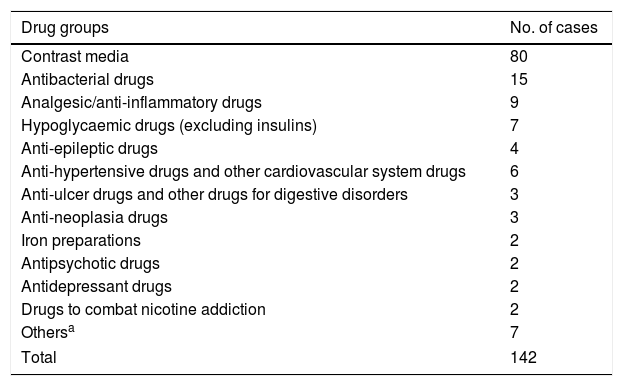This study aimed to gain knowledge of the nurses’ involvement in the spontaneous report of suspected adverse drug reactions (ADR) in the Spanish Pharmacovigilance System for Medicinal Products for Human Use (SEFV-H), describing the principal characteristics of the reported cases, identifying points of improvement.
MethodsA descriptive observational retrospective study was based on the data from FEDRA, the database created by the SEFV-H. The sample taken was the spontaneous adverse drug reactions reported to SEFV-H by nurses during the first 6 months of the 2018.
ResultsComplete data was provided by 6,370 suspicions of ADR reported to SEFV-H by all healthcare professionals. Only 4,8% of the samples were taken by nurses, 62,7% came from medical centers. The majority of the ADR were not considered a serious disease (78%). The most frequently adverse drug reactions reported by nurses were local reactions. The patients most involved were children and vaccines were the most reported drugs (58,3%), followed by the intravenous contrast agents used in diagnostic tests.
ConclusionsNurses report very few cases to SEFV-H and are mostly related to the administration of vaccines and are sent by nurses working in the out-of-hospital setting. Most cases are not serious and usually report known adverse reactions to the suspected drug. This observed under-notification raises the need to promote increased pharmacovigilance training among these notifying nurses so that they can continue to report, and also for those who do not do so in their daily practice, so that they can begin to do so.
Conocer el grado de participación de las enfermeras en la notificación espontánea de sospechas de reacciones adversas a medicamentos (RAM) al Sistema Español de Farmacovigilancia de Medicamentos de Uso Humano (SEFV-H), describir las características principales de los casos notificados e identificar puntos de mejora.
MétodoEstudio observacional descriptivo retrospectivo a partir de la información contenida en la base de datos FEDRA del SEFV-H. Se tomaron como muestra las notificaciones espontáneas de las RAM realizadas por enfermeras durante los seis primeros meses del 2018.
ResultadosDe las 6.370 sospechas de RAM notificadas por profesionales sanitarios en el periodo considerado, tan solo un 4,8% fueron realizadas por enfermeras. El 62,7% procede de centros extrahospitalarios y la mayoría de las RAM son consideradas no graves (78%). Las reacciones notificadas con más frecuencia son las reacciones locales. Los pacientes más implicados son los niños y las vacunas los medicamentos más notificados (58,3%), seguidas de los contrastes intravenosos para la realización de pruebas diagnósticas.
ConclusionesLas enfermeras notifican muy pocos casos al SEFV-H y están en su mayoría relacionados con la administración de vacunas y son enviados por enfermeras que trabajan en el medio extrahospitalario. La mayoría de los casos no presentan gravedad y suelen referir reacciones adversas conocidas para el fármaco sospechoso. Esta infranotificación observada plantea la necesidad de promover la formación en materia de farmacovigilancia entre estas enfermeras notificadoras para que continúen notificando, y también a las que no lo hacen en su práctica diaria, para que puedan comenzar a hacerlo.
Artículo
Comprando el artículo el PDF del mismo podrá ser descargado
Precio 19,34 €
Comprar ahora









